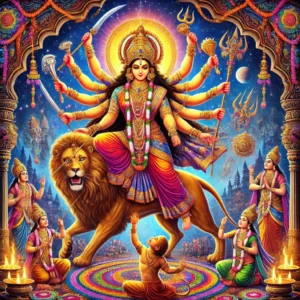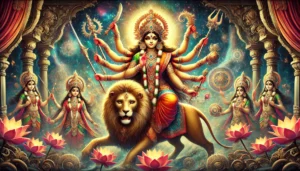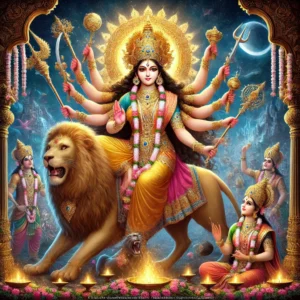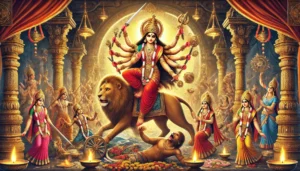
Why is Durga worshipped during Navaratri?
Durga and Navaratri: The Story of Divine Power and Victory Over Evil
Navaratri, one of the most cherished festivals in India, reveres the divine feminine energy in the form of Goddess Durga, the invincible warrior and protector of the universe. This nine-night festival is a grand celebration of Shakti (power) and the eternal victory of good over evil. Beyond its religious significance, Navaratri is a spiritual journey that reflects the timeless truths of the human struggle against darkness, ignorance, and adversity.
The Mythological Origins of Durga
The story of Goddess Durga is deeply rooted in the mythological tales of the Devi Mahatmya, a sacred text that narrates her heroic deeds. Mahishasura, a powerful demon blessed with a boon that no man or god could kill him, grew arrogant and unleashed a reign of terror over the universe. His tyranny left the gods powerless, and the cosmic balance was in peril.
Seeking a solution, the trinity of Brahma, Vishnu, and Shiva united their energies, along with those of other gods, to create Goddess Durga. She was a radiant embodiment of divine power, equipped with celestial weapons gifted by the gods. Each of her ten arms bore a weapon, symbolizing her capability to combat all forms of evil. Mounted on a lion, the symbol of courage and determination, Durga entered the battlefield to confront Mahishasura.
The battle between Durga and Mahishasura raged for nine days and nights. On the tenth day, she slew the demon, restoring peace and order to the universe. This day, known as Vijayadashami or Dussehra, marks the triumph of good over evil and is celebrated with great fervor across India.
Table of Contents

Why is Durga worshipped during Navaratri?
The Nine Forms of Goddess Durga
Navaratri is dedicated to the worship of the nine forms of Durga, each symbolizing a unique quality of feminine divinity. These forms represent different stages of spiritual evolution, guiding devotees on a path of self-discovery and inner strength.
Shailaputri (Daughter of the Mountains): The embodiment of strength and purity, Shailaputri represents the grounded energy needed to begin a spiritual journey.
Brahmacharini (The Ascetic): A symbol of devotion, discipline, and self-control, Brahmacharini encourages perseverance and dedication.
Chandraghanta (The Warrior Goddess): With a crescent moon on her forehead, she represents courage and the destruction of evil.
Kushmanda (The Creator): Known as the cosmic mother, Kushmanda created the universe with her divine laughter, symbolizing energy and vitality.
Skandamata (Mother of Skanda): She signifies nurturing and protection, as the mother of Lord Kartikeya (Skanda), the god of war.
Katyayani (The Fierce Warrior): Created to destroy the demon Mahishasura, Katyayani embodies justice and righteousness.
Kalaratri (The Dark Night): Fierce and destructive, Kalaratri destroys ignorance and darkness, paving the way for spiritual growth.
Mahagauri (The Radiant One): She symbolizes peace, purity, and the ultimate fulfillment of spiritual aspirations.
Siddhidatri (Granter of Perfection): The goddess who grants spiritual wisdom and success, helping devotees achieve their goals.
Each day of Navaratri is devoted to one of these forms, with specific rituals, prayers, and offerings reflecting their unique qualities.

Why is Durga worshipped during Navaratri?
The Spiritual and Cultural Significance of Navaratri
Navaratri transcends mythology and serves as a reminder of the eternal battle between good and evil that exists within each individual. The festival encourages devotees to reflect on their inner strengths and weaknesses, striving to conquer their negative tendencies and embrace positivity.
Fasting and Purification
Fasting during Navaratri is more than a religious ritual; it is a means of detoxifying the body and mind. Abstaining from heavy and tamasic foods (those that promote lethargy) allows devotees to focus on spiritual practices and cultivate a sattvic (pure) lifestyle.
Music and Dance as Devotion
The evenings of Navaratri are marked by vibrant cultural expressions, including Garba and Dandiya Raas. These traditional dances, performed in concentric circles, symbolize the cosmic cycles of creation, preservation, and destruction. They are an expression of devotion and joy, bringing communities together in celebration.
The Universal Relevance of Navaratri
Navaratri is not confined to any particular region or sect. It is celebrated in diverse ways across India and beyond, reflecting its universal appeal. In West Bengal, Durga Puja is the most important cultural event, with elaborately crafted idols of the goddess being worshipped. In Gujarat, the festival is synonymous with Garba and Dandiya, while in Tamil Nadu, the Golu (doll display) tradition represents various scenes from mythology.
Vijayadashami: The Day of Victory
The tenth day of Navaratri, known as Vijayadashami, is a celebration of victory. In many parts of India, effigies of Ravana, the demon king of the Ramayana, are burned, symbolizing the triumph of dharma over adharma. Vijayadashami also signifies new beginnings, with devotees starting new ventures, acquiring knowledge, or purchasing tools and instruments on this auspicious day.
In Bengal, this day is marked by the immersion of Durga idols in rivers and seas, symbolizing her return to her celestial abode. This ritual reminds devotees that the goddess’s power resides within them and that her blessings are eternal.
The Goddess as a Symbol of Feminine Power
Goddess Durga is more than a mythological figure; she is a universal symbol of feminine strength and resilience. In a world often plagued by inequality and injustice, Durga inspires individuals to stand up for righteousness and confront their fears. Her many forms reflect the multifaceted nature of women as nurturers, protectors, and creators.
Conclusion: A Festival of Transformation
Navaratri is a celebration of the divine within and the transformative power of devotion, discipline, and courage. As the lamps are lit and prayers are offered, devotees embark on a spiritual journey to overcome their inner demons and align themselves with dharma.
The festival teaches timeless lessons—of the triumph of light over darkness, knowledge over ignorance, and good over evil. By invoking Goddess Durga’s energy, we honor her victory and strive to embody her qualities of strength, compassion, and wisdom in our daily lives.
As the echoes of the mantra “Ya Devi Sarva Bhuteshu Shakti Rupena Samsthita” (To the goddess who resides in all beings as power) resound, may this Navaratri illuminate your life with hope, positivity, and divine grace.

Why is Durga worshipped during Navaratri?
FAQs on “Durga and Navaratri: Celebrating the Divine Triumph Over Evil”:
- Who is Goddess Durga, and why is she revered?
Goddess Durga is one of the most powerful deities in Hinduism, representing Shakti (divine feminine energy). She is considered the mother of the universe, embodying power, protection, and compassion. She is revered as the destroyer of evil and the protector of righteousness.
- What does Navaratri mean, and why is it celebrated?
Navaratri means “nine nights” in Sanskrit. It is a nine-day festival celebrating the victory of Goddess Durga over the demon Mahishasura. This victory signifies the triumph of good over evil and is a time for spiritual reflection, devotion, and celebration.
- What are the nine forms of Durga worshipped during Navaratri?
The nine forms of Durga, also called Navadurga, are:
Shailaputri: Goddess of nature and purity.
Brahmacharini: Goddess of penance and devotion.
Chandraghanta: The warrior goddess.
Kushmanda: Creator of the universe.
Skandamata: Mother of Lord Kartikeya.
Katyayani: Goddess of courage and justice.
Kaalratri: The fierce form destroying negativity.
Mahagauri: Goddess of peace and serenity.
Siddhidatri: Bestower of supernatural powers and wisdom.
- What is the spiritual significance of Navaratri?
Navaratri is a time for self-purification and spiritual growth. Each day signifies an internal battle against negativity and ignorance, leading to self-realization and enlightenment.
- Why is fasting observed during Navaratri?
Fasting during Navaratri is a way to detoxify the body and mind. It helps devotees maintain discipline, foster a deeper connection with the divine, and focus on spiritual practices like prayer and meditation.
- What are the key rituals of Navaratri?
Kalash Sthapana: Establishing a sacred pot symbolizing Goddess Durga.
Daily Prayers and Aarti: Devotees perform puja and sing hymns.
Fasting: Observing a diet of fruits, milk, and grains.
Offering Flowers and Prasad: Devotees present flowers, fruits, and sweets to the goddess.
Dandiya and Garba: Traditional folk dances performed in her honor.
- How is Navaratri celebrated in different parts of India?
West Bengal: Durga Puja is celebrated with grand idols, cultural performances, and processions.
Gujarat: People perform Garba and Dandiya every night.
South India: Homes display “Golu,” a collection of dolls and figurines.
North India: Ramlila performances depict episodes from the Ramayana, and Dussehra marks the end of Navaratri.
- What is the story of Mahishasura and Goddess Durga?
Mahishasura, a powerful demon blessed with immortality from men, became invincible and wreaked havoc. The gods united their energies to create Goddess Durga, who fought a fierce battle for nine days and nights, ultimately slaying Mahishasura on the tenth day, symbolizing the victory of good over evil.
- What do Durga’s weapons symbolize?
Durga’s ten arms carry various weapons gifted by gods, symbolizing her multi-faceted powers:
Trishul (trident): The power to destroy evil.
Chakra (discus): Infinite energy.
Bow and Arrow: Strength and focus.
Sword: Wisdom and precision.
Lotus: Spiritual awakening.
- What is the significance of colors during Navaratri?
Each day of Navaratri is associated with a specific color that represents the goddess’s qualities, such as red for energy, yellow for happiness, and green for prosperity. Devotees often wear these colors as a mark of devotion.
- What are some traditional foods prepared during Navaratri?
Fasting foods include:
Sabudana Khichdi: Made with tapioca pearls.
Kuttu Poori: Prepared with buckwheat flour.
Aloo Ki Sabzi: Spiced potato curry.
Fruits and Milk: Consumed for sustenance.
- Why is Dussehra celebrated after Navaratri?
Dussehra marks the tenth day after Navaratri, celebrating the victory of Lord Rama over Ravana, paralleling Durga’s triumph over Mahishasura. It symbolizes the ultimate triumph of good over evil.
- What role do music and dance play during Navaratri?
Music and dance, like Garba and Dandiya, are integral parts of Navaratri celebrations. These performances symbolize joy, devotion, and the collective spirit of worship.
- How can modern devotees connect with the essence of Navaratri?
In modern times, devotees can connect by attending community pujas, reflecting on Durga’s teachings, practicing self-discipline, and promoting values like compassion and justice in daily life.
- What life lessons can we draw from Navaratri?
Navaratri teaches resilience, self-belief, and the importance of combating inner and outer evils. It emphasizes that challenges can be overcome through faith, courage, and unity.
Summary
Durga and Navaratri: Celebrating the Divine Triumph Over Evil
Navaratri, a nine-night festival, honors Goddess Durga, symbolizing the victory of good over evil. It commemorates Durga’s battle with the demon Mahishasura, embodying her courage, power, and divine energy. Each day of Navaratri is dedicated to a specific form of Durga, representing various facets of her strength, such as Shailaputri (nature), Brahmacharini (devotion), and Kali (destruction of negativity).
The festival also emphasizes spiritual purification, as devotees fast, meditate, and worship to align themselves with Durga’s energies. The tenth day, Vijayadashami or Dussehra, celebrates the triumph of righteousness, reminding us of the eternal victory of dharma over adharma.
Through cultural practices like Garba and Dandiya, Navaratri unites communities in joyous celebration, blending spirituality with tradition. This festival serves as a profound reminder of resilience, devotion, and the ultimate victory of light over darkness.
Rituals and Practices
Devotees observe various rituals during Navaratri to seek the blessings of the goddess. These include fasting, offering prayers, chanting mantras like the Durga Saptashati, and decorating homes with rangoli and flowers. Special pujas, including the Kalash Sthapana (establishing a sacred pot), are performed to invoke the goddess. Communities organize elaborate Durga Puja pandals with idols of the goddess, which are immersed in water at the festival’s conclusion.
Cultural festivities, such as Garba and Dandiya Raas, are integral to Navaratri, especially in Gujarat and Maharashtra. These traditional dances symbolize joy, devotion, and the collective celebration of divine energy.
Symbolism and Spiritual Significance
Navaratri is not merely a festival but a journey of self-purification and empowerment. The nine forms of Durga represent the progressive path of spiritual growth—from grounding oneself in worldly duties to attaining ultimate liberation.
The festival underscores the idea that the divine feminine resides within all beings, offering strength, wisdom, and protection. It inspires individuals to overcome their inner demons, such as greed, anger, and ignorance, just as Durga defeated Mahishasura.
A Universal Message
While rooted in Hindu tradition, Navaratri conveys a universal message of resilience, hope, and unity. It celebrates the cyclical nature of life, where good inevitably triumphs over evil, and darkness gives way to light. In today’s world, the festival encourages individuals to tap into their inner strength, confront challenges, and emerge victorious in their personal and spiritual lives.
By celebrating Durga and Navaratri, devotees honor the divine power that sustains and nurtures the universe, reaffirming their faith in the eternal victory of good over evil.
Related Articles
- The Tridevi: Lakshmi, Saraswati, and Parvati – Their Roles and Powers
- “Divine Creatures of Ancient Indian Scriptures: Exploring the Role of Animals in the Vedas, Puranas, and Mahabharata”
- Nature and Spirituality: Exploring the Sacred Essence of the Himalayas, Ganga, and Other Natural Wonders”
- “Reviving the Gurukul System: Relevance and Lessons for Modern Education”
- “Exploring Greek and Indian Mythology: Similarities Between Greek and Indian Mythology “
- “Embracing Sattvic Living: Harmonizing Mind, Body, and Soul Through Food and Lifestyle”
- “Charity and Prosperity: Exploring the Concept of Daan and Its Financial Relevance in Modern Life”
- How to Build an Eco-Friendly Home Inspired by Vastu Shastra
- Comparison of Ancient and Modern Sports: How Traditional Sports Have Influenced Contemporary Games
- “Timeless Lessons from Ancient Tales: Linking Samudra Manthan and Ganga’s Descent to Modern Ecological Challenges”
- “Reviving Sanskrit: How AI is Preserving Ancient Languages for the Future”
- “Mathura: The Sacred Land of Lord Krishna’s Divine Leelas”
- Investing for Future Generations: Lessons from Indian Traditions on Legacy Building and Wealth Preservation
- “Ancient Indian Wisdom: Timeless Lessons for Tackling Today’s Climate Crisis”
- “Artificial Intelligence and Spirituality: Transforming Ancient Practices for the Modern World”
- “Gold and Real Estate in India: Timeless Assets Shaping Financial Strategies”
- “Divine Feminine Power in Hindu Mythology: The Legends of Durga, Saraswati, and Lakshmi”
- “Divine Beings of Sanatan Dharma: The Spiritual Significance of Sacred Animals in Hinduism”
- “Symbolism in Mythological Art: Unlocking Hidden Meanings in Ancient Temple Carvings”
- “Exploring Technological Advancements in Ancient India and Civilizations: Vimana, Metallurgy, & Water Management systems”
- Unveiling the Mysteries: Ancient Temples of Sanatan Dharma , Mysterious Temples of India
- “The Scientific Knowledge of Sanatan Dharma: Ancient Wisdom Meets Modern Science”
- Ancient Indian Sports and Games: Celebrating a Legacy of Skill, Strength & Strategy”
- “Exploring the Cosmic Link: The Connection Between Astronomy and Vedic Astrology”
- The Power of Sanskrit: Unlocking the Divine Language of the Gods
- “The End of Kaliyuga: A Sanatan Insight into the World’s Final Chapter”
- Explore more articles on Prachin Sanatan Yuga.
Why is Durga worshipped during Navaratri? Why is Durga worshipped during Navaratri? Why is Durga worshipped during Navaratri?
